“The construction of the world’s largest plug-in hybrid ship is in line with the company’s ambitions for further development of sustainable and environmentally friendly solutions for Norwegian shipping.”
Article and Photos: Mike Louagie
Sustainability of maritime transport took a quantum leap with the introduction of COLOR HYBRID. With a length of 160m and a capacity for 2,000 passengers and up to 500 cars she is the world’s largest plug-in hybrid ferry.
Ferry Shipping News visited the Ulstein shipyard, where she was built, and did a return sailing out of Sandefjord.
We kindly invite you to discover this ship, mainly through photos and a minimum of text.
Norway has always been at the forefront of environmental evolution. Remember the fjord ferry AMPERE, which was in 2015 the world’s first battery electric car ferry, developed and built in Norway. The lithium-ion battery pack onboard AMPERE has an overall output of 1MWh. COLOR HYBRID has a five times higher output. If compared to a Tesla car, COLOR HYBRID’s 5MWh battery pack is the equivalent of 50 Tesla Model S vehicles.
COLOR HYBRID operates on the route Sandefjord (Norway) – Strømstad (Sweden), in the Oslofjord. The photos below show the COLOR HYBRID loading cars in Sandefjord.
A crossing takes 2h30. A typical schedule for this ferry would be to leave the Norwegian port at 10:00. A lot of the revenue is generated by the onboard sales and by Norwegians who travel to Sweden to buy goods that are way less expensive than in Norway, such as food. The 10:00 departure is a very decent time to start a day trip. This is also the busiest crossing, and it also explains why the surface of the shops is so important. If you embark the ship as a foreigner, it is quite surprising to see how passengers are avid to buy. A lot of them only cross for this purpose.
The ship is back in Sandefjord at 16:10, before leaving for Sweden again at 17:00. After performing its second return trip of the day, COLOR HYBRID finally berths in Sandefjord for the night. This is the moment when the batteries are slowly being recharged with a shore power connection, overnight.
The 65-tonne battery pack can power the vessel for almost one hour at a speed of less than 12 knots. This is enough to leave the berth in Sandefjord, and head for the open seas.
Norwegian day passengers, waiting to embark in Sandefjord
Once famous for its whaling industry, Sandefjord is now a modern yet charming seaside town and a popular holiday destination for Norwegians. The city has large forests and numerous sandy beaches that offer scope for relaxation year-round. In between the sandy beaches lie a series of sheltered coves and beautiful smooth, sloping rocks. To keep the environment as pure as possible Color Line wanted to have a ship that did not produce any emissions whilst sailing in the fjord. It fits in the company’s overall plan to reduce greenhouse gas emissions, in line with what Norway wants to achieve as a country.
The overnight charging is not enough to give the batteries sufficient stamina for the day. The onboard engines do help charge during the sailing.
On the other hand, the battery power is also being used to help absorb peak loads, which results in a lower fuel consumption.
Passengers arrive in the heart of the ship, which is the reception area (Deck 6, starboard).
A compass rose, embedded in the floor, marks the central plaza of the reception area.
The most obvious breakfast, lunch or dining option is at the Koster Buffet, the Scandinavian-style self-service restaurant on Deck 6.
Koster Buffet has three main sections, with the most popular one with the panoramic bow view.
The different sections can be privatised for conferences.
Spiseriet Café is the place for people who want something fast and simple. Juicy burgers, fresh salads, cakes, freshly baked buns and much more are being sold here.
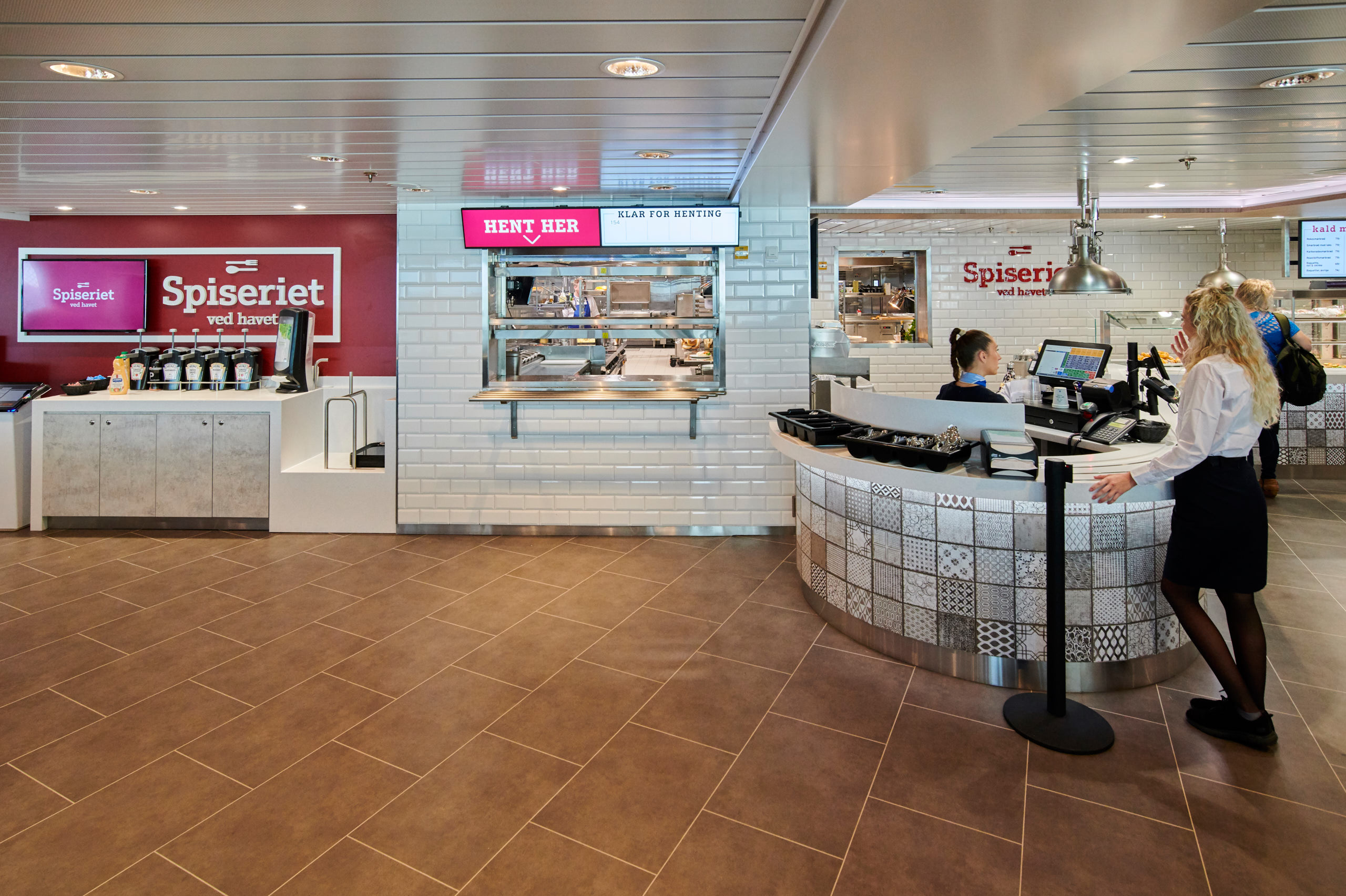
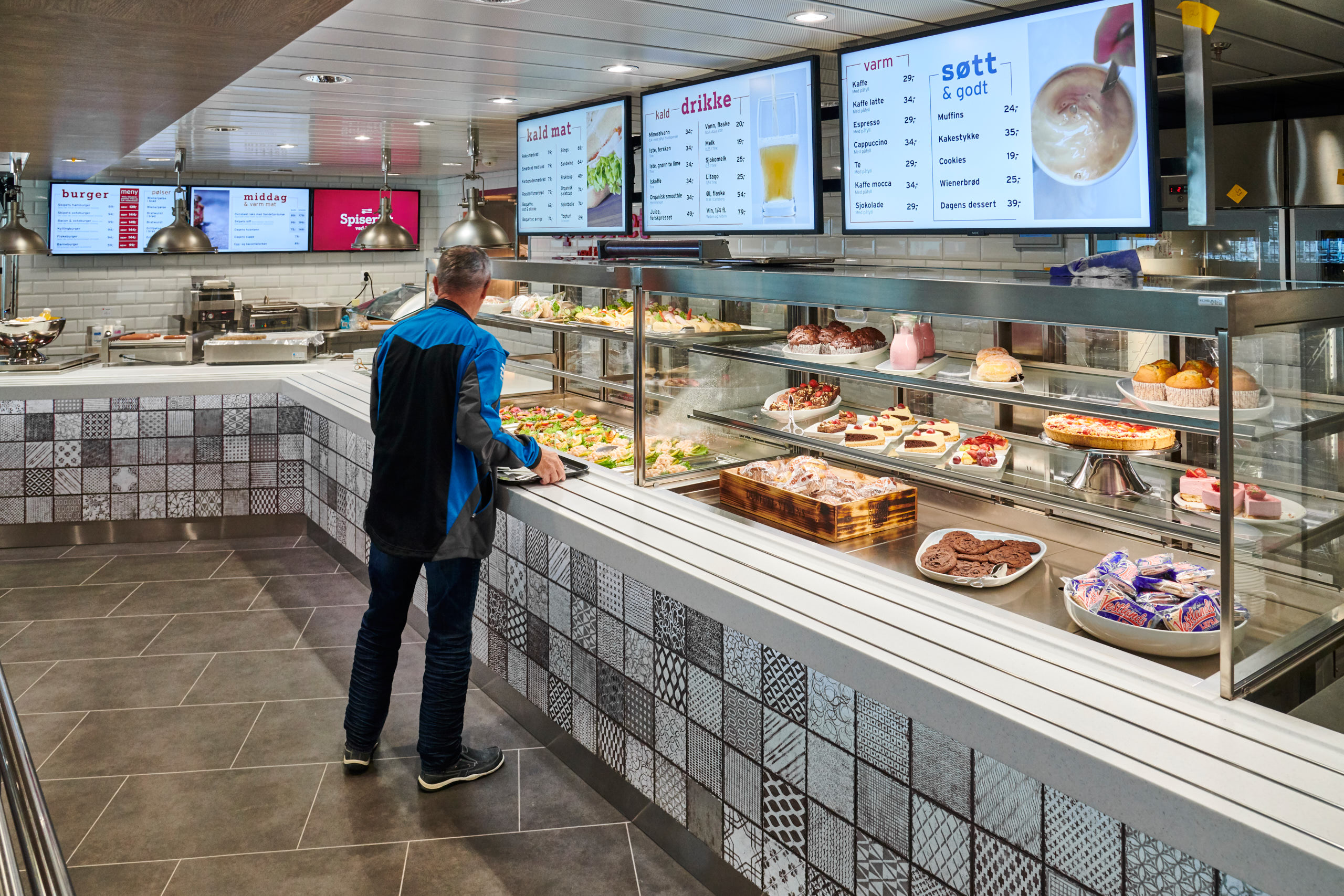
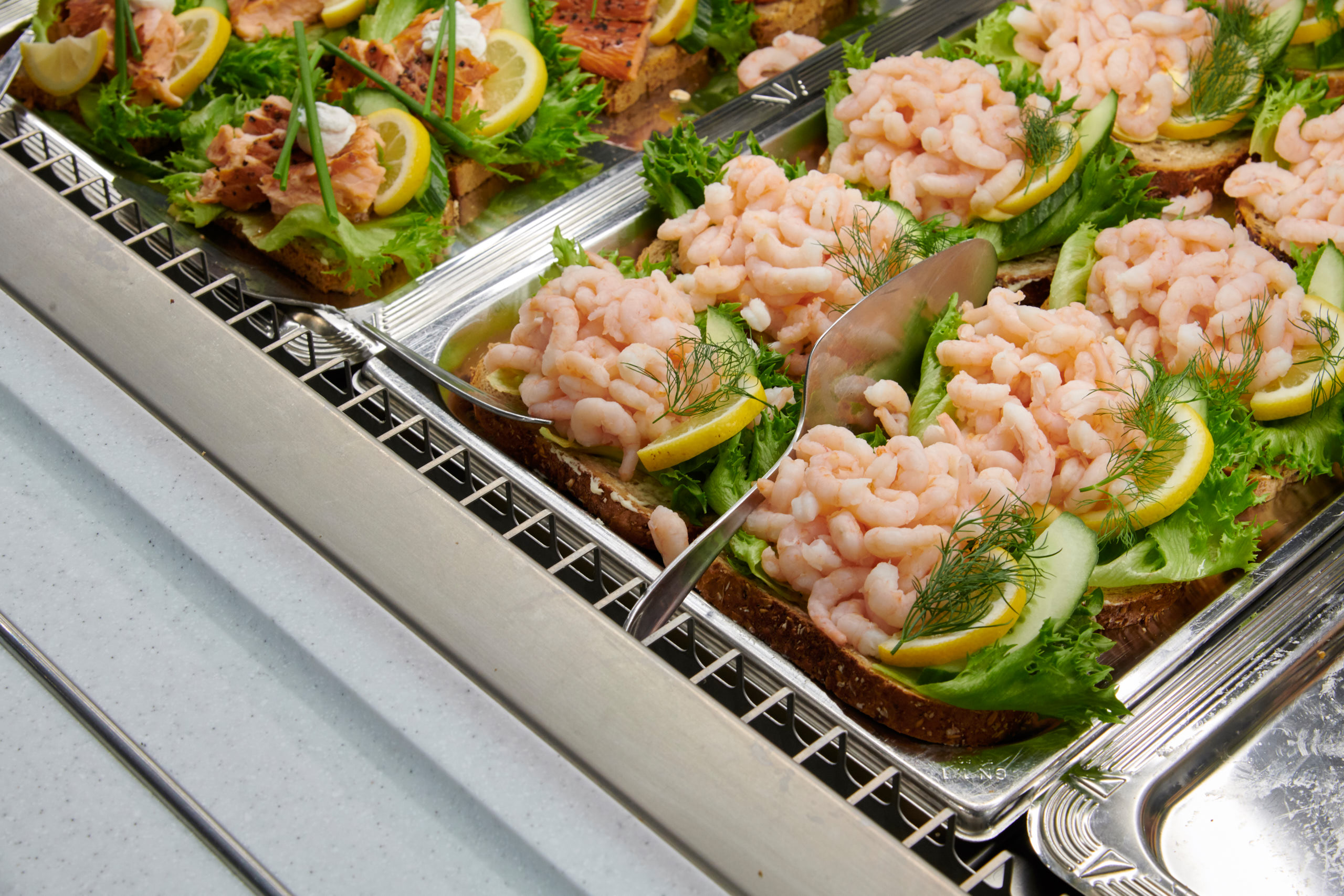
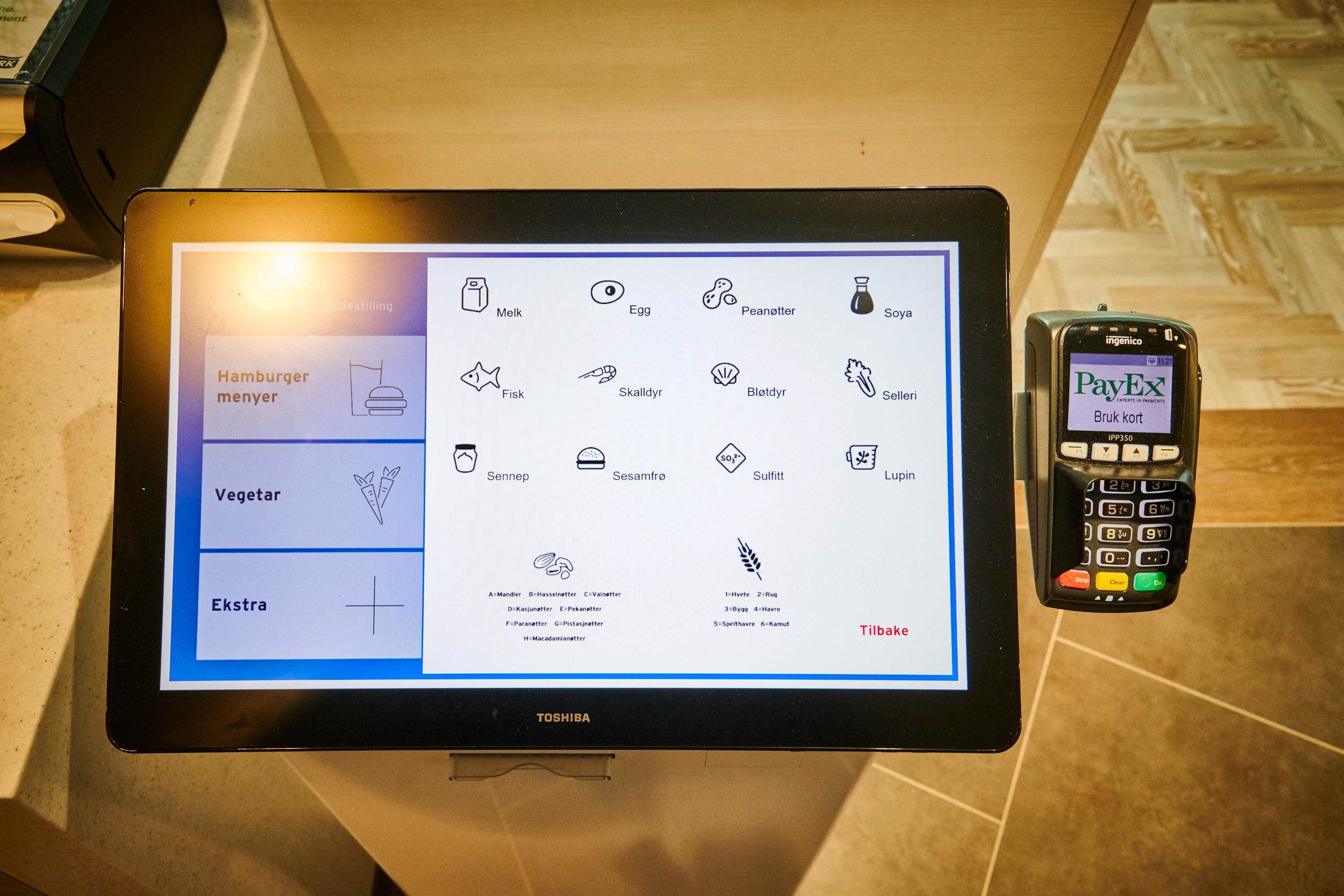
People can either take cold food from the buffet or order hot food via the touch-screen tablets. Once it is ready the meal can be collected at a till next to the cashier
The third place for food (and drinks) is the Utsikten Bar & Lounge. In this place a tasting menu is being served. Passengers are asked to book a table in advance.
Utsikten means ‘view’, and indeed, this place on Deck 8 aft offers plenty of opportunities to enjoy the surrounding landscapes.

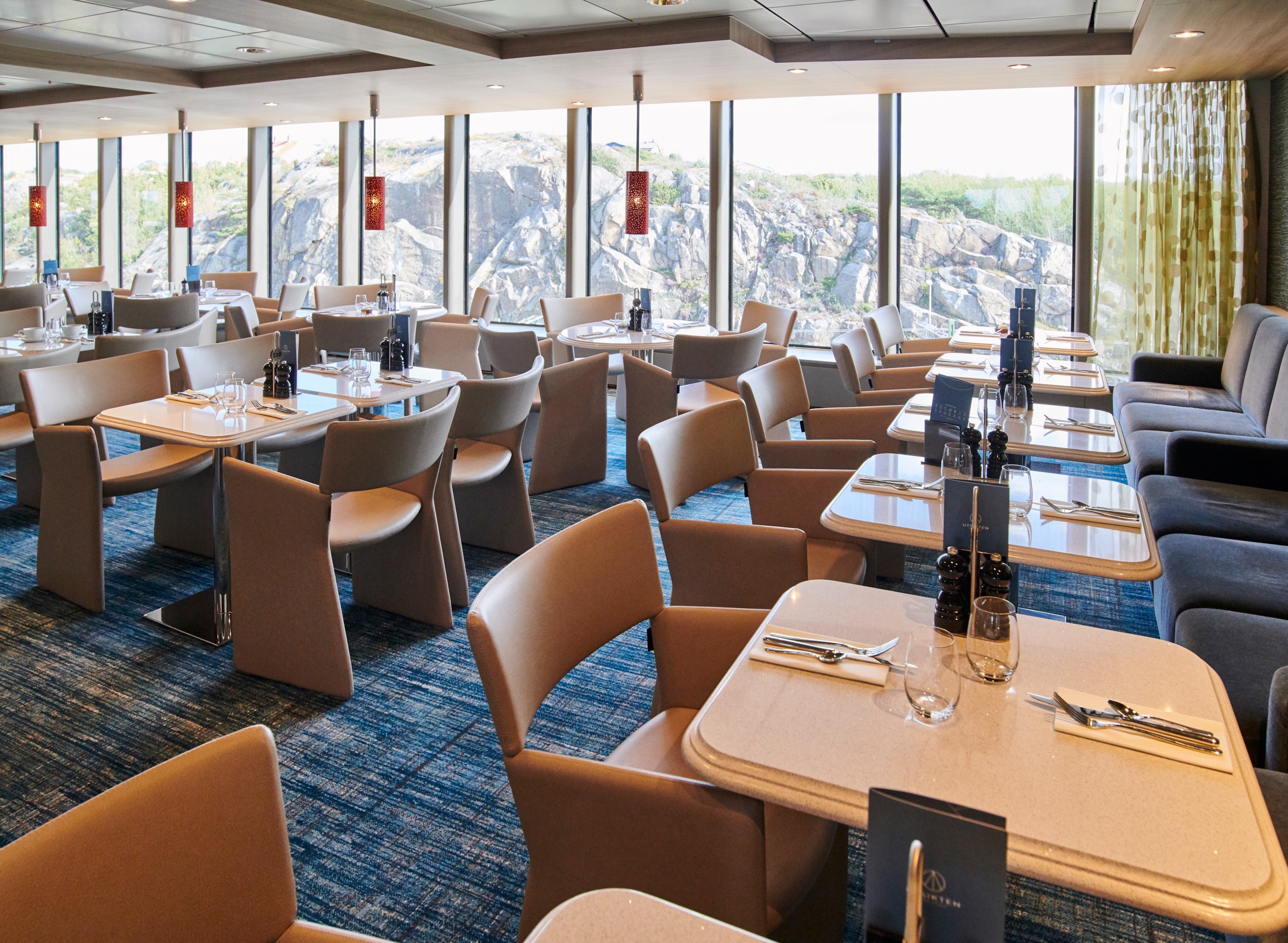

Utsikten even has two bridge wings for passengers. They give a panoramic view, almost 20m above the sea level.
If electricity and MDO are the fuels for the engines, shopping could be the energy that makes the commercial operation a success.
The 2,000m2 of shops can be divided in two groups: the Taxfree Market and the Color Shop.
The Taxfree Market is a 1,100m2, modern duty-free store with perfume, sweets, alcohol, tobacco, wine and sweets.
The Color Shop offers more than 800m2 of clothing, shoes, toys, sports, electronics, gift items and more. It is located aft on Decks 6 and 7. The large panoramic window creates a very positive atmosphere. Attracted by the view and the light, passengers might want to stay longer.
This lounge on Deck 6 forward is a place to enjoy the view and to relax in the reclining chairs.
Red, blue and green are the three colour codes consequently used in staircases and lifts.
The beauty of the landscapes, both on the Norwegian and the Swedish side, can be fully enjoyed from the outer decks.
The ship has been conceived by Fosen Ulstein Design and Engineering (FUDE), on behalf of Fosen Yard. Saving energy has from the beginning been of paramount importance to the design process.
One of the important issues was to have the best possible fire-resistant, sound- and thermal- insulation for the vessel, without losing efficiency through weight issues. “Saving weight through the insulation is important because this is placed high up in the ship. Weight reduction higher up improves stability. This increases the loading capacity even more than the weight reduction would indicate. It also saves on fuel. But there are so many factors involved that it’s difficult to give a concrete figure of how much is saved,” says Tomren.
The insulation was provided by GLAVA®, a Norwegian company specialised in all kinds of insulation. For COLOR HYBRID, they used products from the ‘U seaprotect’ range from Isover.
Compared to traditional mineral wool insulation, a 40% reduction in weight has been achieved, claims the company on its website.
Color Line’s project director Robin Tomren sees a threefold better thermal insulation between inside and outside, compared to previous ship.
COLOR HYBRID also has a 5MWh heat reservoir, which stores waste heat originating from the cooling water and the exhausts. It is sufficient to heat the ship 24 hours a day. Some waste heat is being used for the greenhouse on the upper deck. It is a real greenhouse, where herbs are being grown for the ship’s galleys.
Another unique solution has been created by using the vessel’s heeling-tanks also as a storage for hot water.
Together with an optimal hull design, all combined efforts have led to a reduction of 33% of CO2, compared with a ro-pax of a similar size. The consumption of (fossil) fuel has also been lowered by 20%.
“Being a day ferry catering to the tax-free trade between Norway and Sweden it was imperative that the logistics and shopping and catering areas were forefront in the design. Having 2,000 passengers and 500 cars on a 2,5-hour crossing required this,” says Cecilia Kinnison, Interior Architect & Managing Director, Kinnison Design AB, Sweden
She explains the two main underlying ideas on COLOR HYBRID.
“One is the achievement of a feeling of openness and ‘borderless-ness.’ It means no doors to public spaces, just openness and ease of transition, so that everyone feels welcome. This, combined with tall panorama windows to give an ‘infinity effect’ to the outside adds to the sense of light and spaciousness.”
“The second main idea was to create a general arrangement with an interior-exterior that encourages the passengers to have a sense that they can move freely on all four passenger decks (6-7-8-9) with integrated ‘exclamation points’ within the spaces that create personality and hopefully encourage a sense of pride on the part of the passengers and crew.”
“Each public space is a destination offering something unique. The goal was to create memorable, modern interiors for Color Hybrid. She was meant to feel like the younger sister in the fleet yet retain certain maritime elements typical of Color Line,” Cecilia Kinnison concludes.
The financing of COLOR HYBRID is based on loans from the Export Credit Agency (ECA) with guarantees from GIEK (Norwegian Export Credit Guarantee Agency – Garantiinstituttet for eksportkreditt) and from a commercial bank (DnB Bank Norway). GIEK’s guarantee amount is a nominal value of NOK 790 million.
Together they funded 80% of the project for a value of approximatively NOK 1 billion, over a 12-year period.
70% of what has been supplied for the newbuilding come from companies in the maritime cluster in Norway, and especially from the Sunnmøre cluster (with Ålesund as main city).
Source: GIEK
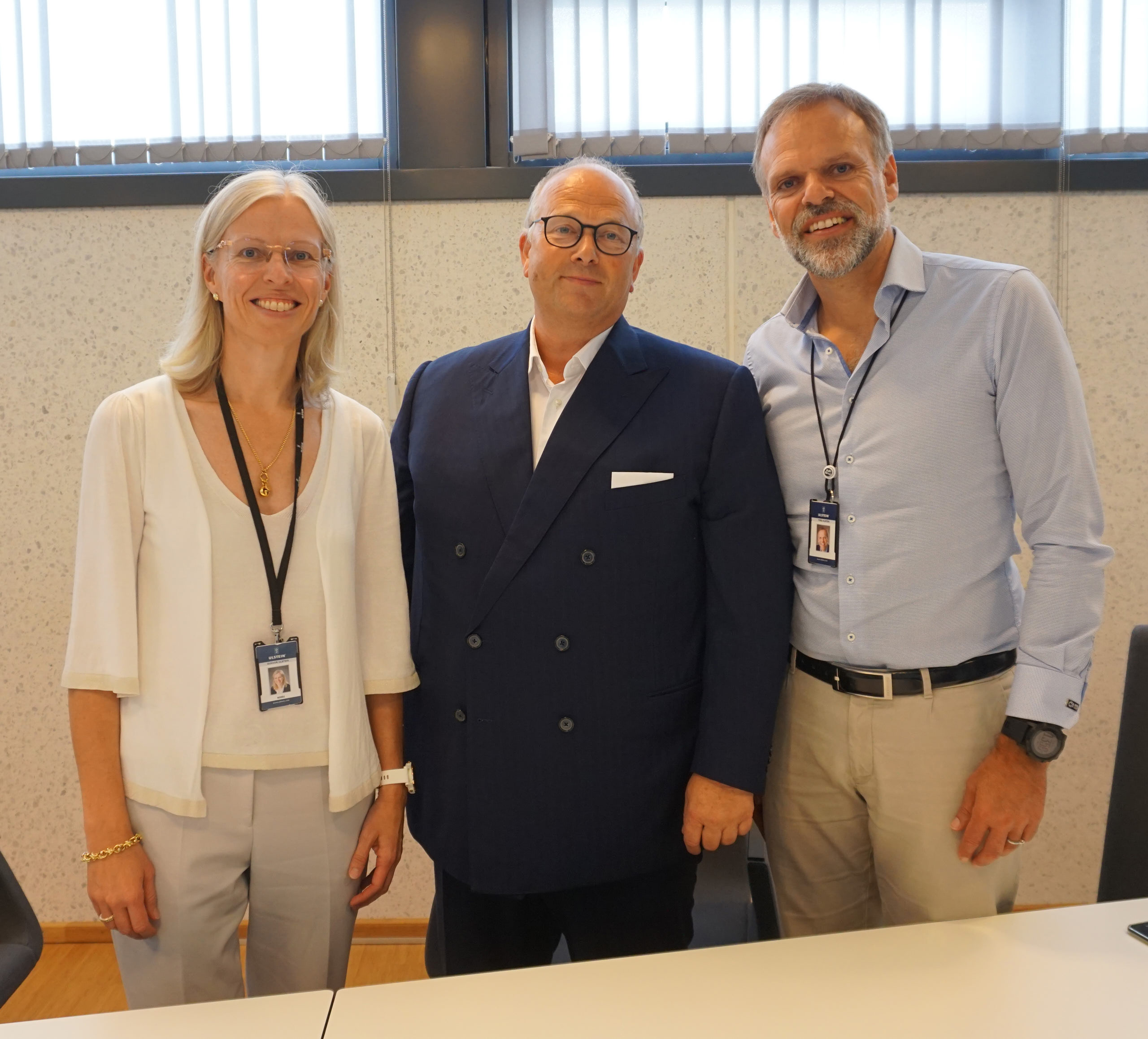
From left to right: Gunvor Ulstein (CEO Ulstein Group), Trond Kleivdal (Group President of Color Line), Tore Ulstein
(Deputy CEO, COO Design & Solutions and chief market & innovation officer Ulstein Group). This picture was taken on 1 August 2019, when Color Line officially took over the ship from Ulstein Verft. (photo courtesy Ulstein)
Key dates:
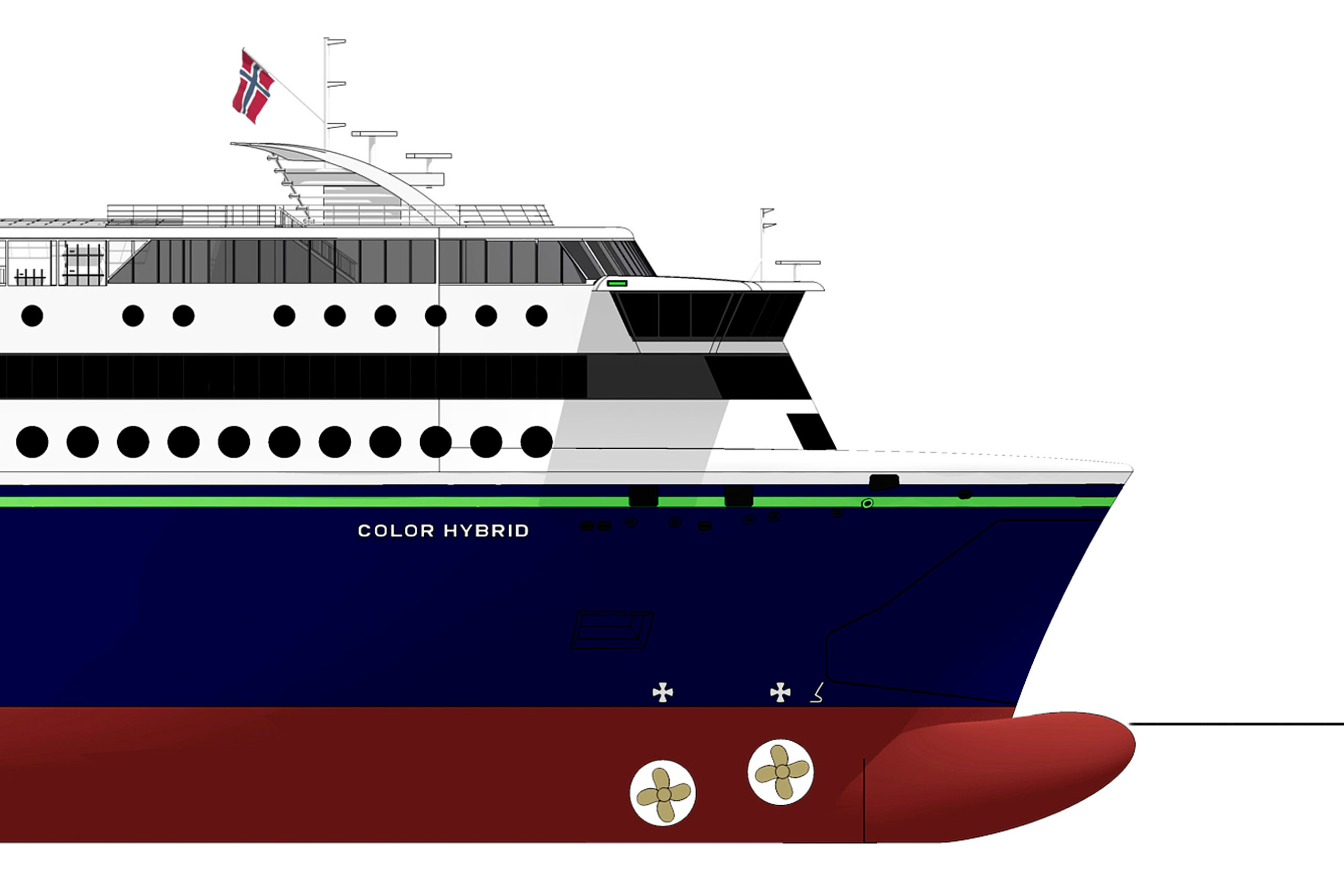
Classification
DNV-GL* 1A, FERRY A, CLEAN, NAUT(OC), TMON, COMF(C(2)V(2)), ICE(1B), MCDK, LCS(DC), BIS, F(MC), BATTERY(POWER), VIBR, RECYCLABLE, BWM(T)
Principal Dimensions
Capacities
Technical Data
Main Engines: Kongsberg Maritime
Battery pack: Siemens
Switchboards: Clean Marine Switchboards
Propeller, thrusters: Brunvoll
Steering system: Damen Marine Components
Liferafts: Mare Safety / Viking Norsafe
Rescue ships: Palfinger
Furnishings: R&M Ship Interior
Noise control: Weber
Navigation / Communication Equipment: Kongsberg Maritime
Communication system: Ulstein Power & Control
Cable / pipe penetrations: Roxtec
Pumps: Allweiler
Fuel seperator: Alfa Laval
Cash register: Checkmark
Valves: Ahlsell
Sandblasting / surface: Westcoats
Galley Furnishings: R&M Ship Interior
Bathroom modules: Norac
Doors: Libra Plast
Decorative lighting: Elpro
Vacuum Toilet: Jets
Fiber reinforced floors: Weber
Noise control: Weber
Navigation / Communication Equipment: Kongsberg Maritime
Communication system: Ulstein Power & Control
Cable / pipe penetrations: Roxtec
Pumps: Allweiler
Fuel seperator: Alfa Laval
Cash register: Checkmark
Valves: Ahlsell
Sandblasting / surface: Westcoats
Ulstein shipbuilding celebrated its 100th anniversary in 2017.
The family-owned company is based in Sunnmøre, the area near Ålesund in Norway.
The yard has a solid reputation for the construction of sophisticated vessels, such as subsea ships, offshore supply vessels, seismic research vessels, windfarm ships, anchor handling tugs etc…
The yard is currently building two expedition cruise vessels for Lindblad National Geographic. The patented X-Bow will help to enhance passenger comfort by reducing motion (sickness).